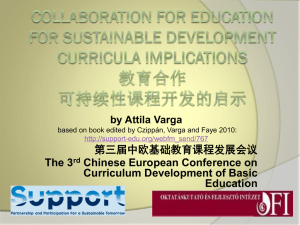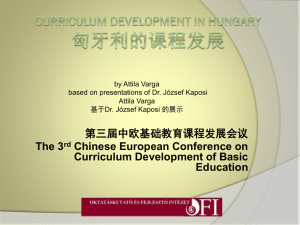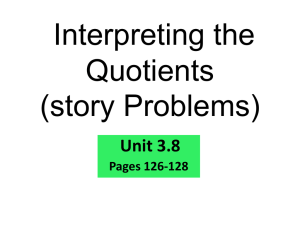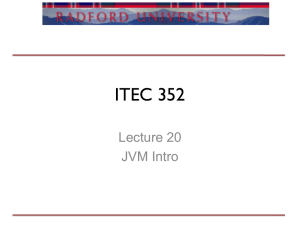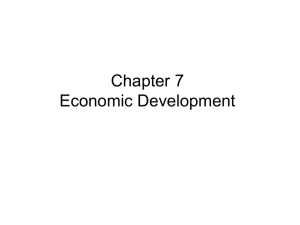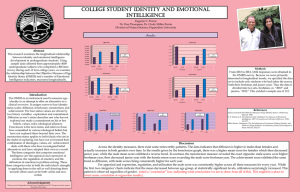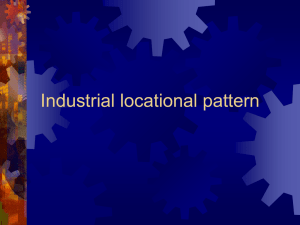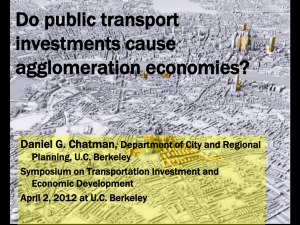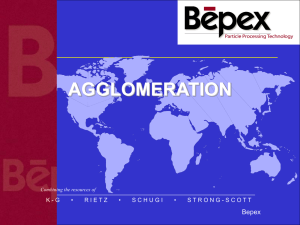The GMR approach
advertisement
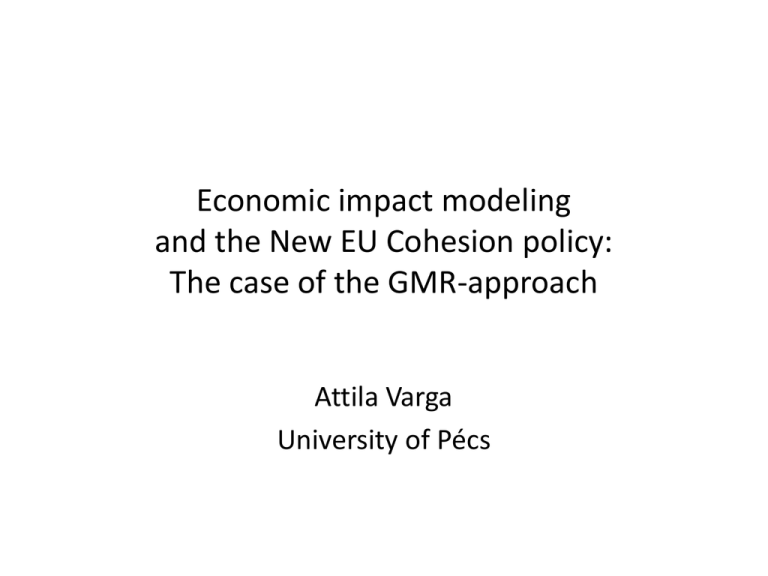
Economic impact modeling and the New EU Cohesion policy: The case of the GMR-approach Attila Varga University of Pécs Introduction • The modern development policy paradigm – Disappointment in traditional convergence-oriented policies – Focus: overall economic growth instead of regional convergence – Awareness of the role of geography in growth stimulation • Two recent approaches: – Space neutral: to strengthen agglomeration forces in the economic core with spatially blind interventions – World Bank (2009) – Place-based: to utilize growth opportunities in all regions with integrated regional-specific development interventions – Barca (2009), OECD (2009) 1 Introduction • Space-neutral or place-based? “The debate, then, is not whether policies should be spatially-blind or place-based, rather how to ensure these policies enhance each other, are well synchronised, and do not work against each other.” Oliveira et al (2014) 2 Introduction • Important aspects of policy assessment: – Overall policy impact of a certain policy budget (at the national and supranational level) depends not only on the specific instruments applied but also on the concrete geographic patterns in which these instruments are deployed regionally 3 Introduction The role of geography in policy effectiveness 1. Interventions happen at a certain point in space and their impacts are related to regional structural features (industrial specialization, factor endowment, agglomeration effects, institutional development). 2. Regional impacts influence other locations (through proximity and interregional network effects, interregional trade). 3. Interventions lead to a cumulative long run process resulting from labor and capital migration which further amplify/reduce the initial impacts in the region and related other locations. 4. Different spatial patterns of interventions might result in significantly different growth and convergence/divergence patterns. 4 Introduction A pronounced need towards the incorporation of the role of geography in policy assessment: “As policy-makers have limited knowledge on how and where to intervene, the spatial effects of all national and supranational policies should be made explicit. Because there are strong interdependencies between places, the spatial consequences of exogenous intervention need to be assessed and compared.” (Barca 2009, p. 24) 5 Introduction • The related role of economic models: – Specially constructed economic models could provide information for policymakers in the assessment of the spatial consequences of various policy shocks. – These models could also provide information in comparing the effects of different projects following particular geographic and instrumental combinations of a set of instruments. 6 Introduction • Economic impact models and modern development policy: – Traditional macroeconomic models (econometric, CGE, DSGE) • Do not reflect geographical effects (agglomeration, migration, interregional trade, spillovers, regional economic structures) – Regional and interregional CGE models • Do not reflect the influence of macroeconomic factors (macroeconomic conditions/policies) on the effectiveness of regional interventions 7 Introduction • Search for new modeling approaches (MASST, GMR-type models (GMR-Hungary, GMREurope, RHOMOLO), system dynamic approach) • This presentation: – classifies the challenges towards economic modeling; – illustrates a reflection to the challenges by the GMR- Europe model. 8 Outline • Modeling challenges • The GMR-approach • Reflections to the challenges in the GMREurope model • Policy simulation examples 9 Modeling challenges • Step 1: Modeling policy impact on regional technological progress – Incorporation of the mechanisms discovered in the geography of innovation literature: local / global knowledge flows, different agglomeration effects (MAR or Jacobs, related variety), entrepreneurship – Modeling possibilities: • knowledge production function (Varga et al 2013) • evolutionary techniques (Faggiolo, Dosi 2003) 10 Modeling challenges • Step 2: Modeling the transmission of the technology impact to economic variables – Productivity and variety impacts (Saviotti, Pyka 2003) – What growth theories offer: • Romer 1990 – productivity impact at the end • Aghion, Howitt 1998: limited variety impact • Evolutionary theories get closer to formulating variety effects (Saviotti, Pyka 2003, Faggiolo, Dosi 2003) – Technical difficulties, problems with regional data 11 Modeling challenges • Step 3: Modeling spatiotemporal dynamics of economic growth – Spatiotemporal dynamics modeling: accounting for both the direct indigenous extension of production factors and their changing spatial patterns via factor migration – Option 1: Spatiotemporal dynamics modeled at the level of regions • Forward looking expectations (Bröcker, Korzhenevych 2011) • Alternative investment and saving behavior (Ivanova et al 2007) – Option 2: Spatiotemporal dynamics modeled separately in macro and regional models (Varga et al. 2011) 12 Modeling challenges • Step 4: Macro impact integration – Impacts of macroeconomic framework conditions – New and open area of research (Varga et al. 2011) 13 The GMR-approach • provides an integrated framework for – a comparative assessment of alternative regional policies on the basis of their overall impact on national growth; – the incorporation of macroeconomic factors in the impact assessment of regional interventions. 14 GMR: Geographic Macro and Regional modeling 15 Why “geographic”? • To emphasize that the role of geography in development policy impacts is placed at the core of the models. 16 Why „regional”? • Spatial reference unit where interventions happen 17 Why „macro”? • Macro level impacts form the basis of the overall evaluation of alternative regional interventions. • Awareness of the role of macroeconomic factors in regional policy effectiveness. 18 The GMR approach: Antecedens and applications • Antecedents: – Links to theory: Acs-Varga 2002 – Empirical modeling framework (Varga 2006) – The EcoRet model (Schalk, Varga 2004, Varga, Schalk 2004) – The GMR-Hungary model (Varga, Schalk, Koike, Járosi, Tavasszy 2008; Járosi, Koike, Thissen, Varga 2010) – Dynamic KPF model for EU regions (Varga, Pontikakis, Chorafakis, 2013) – GMR-EU (Varga, Járosi, Sebestyén 2011; Varga,Törma 2011) – GMR-HUNGARY II (Varga, Járosi, Sebestyén, 2013) • Applications: Cohesion Policy impact studies for the European Commission (DG Regio) and the Hungarian government; FP6 impact study Structure of GMR models – a regional Total Factor Productivity (TFP) block – a regional Spatial Computable General Equilibrium (SCGE) block – a macroeconomic (MACRO) block 20 Reflections to challenges in the GMREurope model • Step 1: Modeling policy impact on technological progress (TFP block) – Spatialised extension of the Romer 1990 knowledge production model incorporating several elements of the findings in the geography of innovation literature (Varga et al 2013, Sebestyén, Varga 2013): • Dynamic agglomeration effects • Interregional knowledge flows (co-patenting, co-publication network effects) • Interregional spillovers – with no specific mechanisms identified (spatial econometrics) 21 R&D productivity publications Regional attractiveness: R&D R&D Regional attractiveness: knowledge industries Knowledge industry concentration R&D productivitypatenting Interregional research networks Patenting in proximate regions Patenting National technological development Regional technological development Social capital Human capital Industrial concentration TFP Technological development in proximate regions Figure 1: The estimated regional dynamics of innovation policies in the TFP block of the GMR-Europe model 22 Reflections to challenges in the GMREurope model • Step 2. Modeling the transmission of the technology impact to economic variables (TFP block) – Technological ideas channeled through their TFP effects: aTFP1SOCKAPi,t-k TFPi,t = aTFP0 HCAPi,t-k aTFP 2 ln( Li,t-k AREAi ) Ai,t-k aTFP 3 W _ Ai,t-k 23 Reflections to challenges in the GMREurope model • Steps 3 and 4: Modeling spatiotemporal dynamics of economic growth and macro impact integration (SCGE and MACRO blocks) – Step 3a: Short run regional equilibrium (given K and L, no migration) – system of regional CGE models – Step 3b: Spatial dynamics via migration and altered regional TFP – in the system of regional CGE models – Step 3c: Dynamic aggregate impacts on K and L: the macro model – Step 4: Aggregated impacts distributed over regions 24 !!! Policy Spatiotemporal dynamics Impacts MACRO block Changes in aggregate K and L DTFPN,t Regional SCGE block Spatial equilibrium with given KN and LN DLi,t ! R&D, human capital, physical accessibility Macroeconomic (TFP, K, L, Y, inflation, wages, etc.) DKN,t DLN,t Regional (TFP, K, L, wages, prices) DTFPi,t Regional TFP block Policy-induced changes in TFP ! Figure 2: Regional and macro impacts of regionally implemented innovation policies in the GMR-Europe model 25 26 0,3000% 3,5000% 0,2500% 3,0000% 2,5000% 0,2000% 2,0000% 0,1500% 1,5000% 0,1000% 1,0000% 0,0500% 0,5000% 0,0000% 0,0000% 2009 2010 2011 2012 2013 2014 2015 2016 2017 2018 2019 2020 2021 2022 2023 2024 2025 2026 2027 2028 Orig 2009 2010 2011 2012 2013 2014 2015 2016 2017 2018 2019 2020 2021 2022 2023 2024 2025 2026 2027 2028 Agglomeration The Agglomeration effect: Greece 0,9000% Orig Agglomeration The Agglomeration effect: Portugal 1,4000% 0,8000% 1,2000% 0,7000% 1,0000% 0,6000% 0,5000% 0,8000% 0,4000% 0,6000% 0,3000% 0,4000% 0,2000% 0,2000% 0,1000% 0,0000% 0,0000% 2009 2010 2011 2012 2013 2014 2015 2016 2017 2018 2019 2020 2021 2022 2023 2024 2025 2026 2027 2028 Orig 2009 2010 2011 2012 2013 2014 2015 2016 2017 2018 2019 2020 2021 2022 2023 2024 2025 2026 2027 2028 Agglomeration The Agglomeration effect: Czech Republic Orig The Agglomeration effect: Hungary 1,4000% 0,1200% 1,2000% 0,1000% 1,0000% Agglomeration 0,0800% 0,8000% 0,0600% 0,6000% 0,0400% 0,4000% 0,0200% 0,2000% 0,0000% 0,0000% 2009 2010 2011 2012 2013 2014 2015 2016 2017 2018 2019 2020 2021 2022 2023 2024 2025 2026 2027 2028 Orig Agglomeration The Agglomeration effect: Slovak Republic 2009 2010 2011 2012 2013 2014 2015 2016 2017 2018 2019 2020 2021 2022 2023 2024 2025 2026 2027 2028 Orig Agglomeration The Agglomeration effect: Euro zone + CZ, HU, SK Figure 6: Results of the Agglomeration and concentration scenario Percentage differences between scenario and baseline GDP values. 27 3,5000% 0,3000% 3,0000% 0,2500% 2,5000% 0,2000% 2,0000% 0,1500% 1,5000% 0,1000% 1,0000% 0,0500% 0,5000% 0,0000% 0,0000% 2009 2010 2011 2012 2013 2014 2015 2016 2017 2018 2019 2020 2021 2022 2023 2024 2025 2026 2027 2028 2009 2010 2011 2012 2013 2014 2015 2016 2017 2018 2019 2020 2021 2022 2023 2024 2025 2026 2027 2028 Orig Donut Orig Donut The Donut effect: Greece The Donut effect: Portugal 0,9000% 1,4000% 0,8000% 1,2000% 0,7000% 1,0000% 0,6000% 0,5000% 0,8000% 0,4000% 0,6000% 0,3000% 0,4000% 0,2000% 0,2000% 0,1000% 0,0000% 0,0000% 2009 2010 2011 2012 2013 2014 2015 2016 2017 2018 2019 2020 2021 2022 2023 2024 2025 2026 2027 2028 2009 2010 2011 2012 2013 2014 2015 2016 2017 2018 2019 2020 2021 2022 2023 2024 2025 2026 2027 2028 Orig Donut The Donut effect: Czech Republic 1,6000% Orig Donut The Donut effect: Hungary 0,1200% 1,4000% 0,1000% 1,2000% 0,0800% 1,0000% 0,8000% 0,0600% 0,6000% 0,0400% 0,4000% 0,0200% 0,2000% 0,0000% 0,0000% 2009 2010 2011 2012 2013 2014 2015 2016 2017 2018 2019 2020 2021 2022 2023 2024 2025 2026 2027 2028 2009 2010 2011 2012 2013 2014 2015 2016 2017 2018 2019 2020 2021 2022 2023 2024 2025 2026 2027 2028 Orig Donut The Donut effect: Slovak Republic Orig Donut The Donut effect: Euro zone + CZ, HU, SK Figure 5: Results of the Donut scenario Percentage differences between scenario and baseline GDP values. 28
